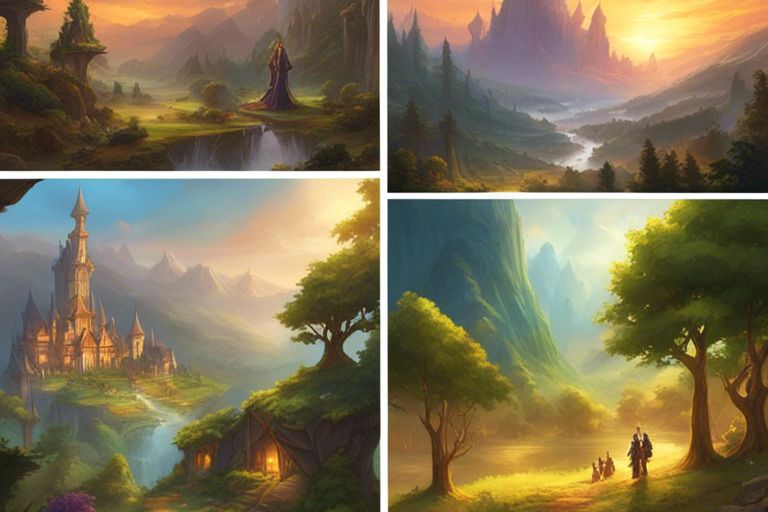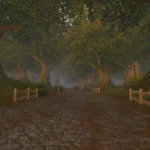Environmental Storytelling
Quest design isn’t just limited to the tasks assigned to you; it extends into the very fabric of the environment in which you operate. Environmental storytelling is a principle embedded into the game that allows the world around you to narrate its own tale, often without the need for explicit dialogue and quest text. Throughout your journeys, you’ll notice how the landscapes, architecture, and even NPC placements reinforce a sense of history and lore. An abandoned village can tell of a past turbulent battle, while the vibrant flora of Nagrand showcases the beauty that was once a war-ravaged land.
Quest lines and interactions often complement these environmental elements. As you traverse through the zones, you uncover the implications of your quests on the surrounding environment, leading to a more personal and emotional understanding of your character’s role in the greater narrative. This connection enhances the significance of your actions, as you realize that each quest carries weight and reverberates through the world, shaping the landscapes you traverse and the characters you meet.
Through this intricate design, the game world narratively unfolds, enveloping you in a rich tapestry of history and conflict. You not only see the aftermath of previous events; you are an active participant in them, adding layers of complexity to what it means to quest in this classic gaming experience. When you engage with the environment during quests, the feeling of being a part of something greater than yourself becomes palpable, solidifying your sense of immersion.

Community Engagement and Social Connectivity
Not only does World of Warcraft (WoW) 1.12 serve as a benchmark for gamers who hold dear memories of the early days of MMO gaming, but it also cultivated a deep sense of community among its players. There’s an undeniable charm in the way that guilds are stitched into the very fabric of the game. Guild Dynamics and Their Evolution illustrate how these social frameworks have changed and how they influence player interaction. The early days of WoW relied heavily on forming bonds over shared quests and the thrill of shared victories over bosses. As you progressed, you likely found yourself immersed in the ambitious goals of your guild, where milestones were not merely personal achievements but collective triumphs that brought players closer together. Members were not just numbers; they became friends, confidants, and sometimes, lifelong comrades united by a common cause.
The advent of guild-specific events and the crafting of guild identity were significant aspects that shaped your experience within a guild. Over time, guilds began incorporating roles and responsibilities, leading to a more organized and efficient way to tackle the game’s challenges. You might remember joining a guild that specialized in PvP or PvE, each one forging a unique culture and game style that attracted specific types of players. The evolution of these guilds not only highlights personal and gameplay growth but also signifies how communication tools—such as forums, voice chat, and social media—became crucial for planning and engagement. With the rapid advancement of technology, the gaming experience began to transcend the confines of the game world, enabling richer communication and collaboration.
If you dig deeper into how guild dynamics have shifted, you’ll notice how inclusion and diversity became a priority within many guilds. New players were often welcomed with open arms, encouraging not only retention within the game but also fostering a broad community spirit that transcended faction lines. Experienced players took on mentoring roles, which in turn nurtured a sense of belonging. As you journeyed through quests and raids, you likely found yourself enmeshed in a network of interdependent relationships that made the experience oh-so-rewarding. The evolution of guild dynamics reflects the growing importance of collaboration in gaming and underscores how players integrated their in-game roles with their real-world personalities.
Coordinated Raids and Group Activities
One of the most exhilarating aspects of your WoW journey was undoubtedly the coordinated raids and group activities. Raids were not just about defeating a challenging boss; they were grand social events that demanded planning, cooperation, and synergy from all participating members. The thrill of gathering your guildmates, strategizing for hours, and finally stepping into a raid armed with well-laid plans only to experience the chaos of battle was intoxicating. You probably remember the adrenaline rush that kicked in as you faced off against formidable foes, knowing your successes or failures hinged upon each player performing their roles flawlessly. These encounters defined how you interacted with others as well as shaped your gaming identity.
The depth of involvement in coordinated raids surged beyond mere participation; it evolved into a rite of passage within your guild community. Over time, you became proficient in your character’s abilities and learned to communicate effectively, adopting a blend of analytical and technical skill. This newfound expertise fostered a bond with your guild members that extended well beyond the confines of the game. Understanding raid mechanics, using voice communication systems, and creating strat guides were all part of the exhilarating experience that bonded you more closely with your peers. You can’t overlook how vital coordination and timing became; missing a beat often meant the difference between victory and defeat, reinforcing the importance of teamwork.
For instance, some of the most memorable moments likely stemmed from an unforeseen challenge during a raid. Imagine a moment where a player unintentionally triggers a boss ability, prompting a series of frantic calls and reactions. These moments ultimately create rich stories that deepen your connection to the game and its community. The lasting camaraderie forged during these high-stakes instances kept players returning to the game, reigniting the flame of alliances and friendships through collective efforts. The community engagement you experienced through coordinated raids has been a defining aspect of WoW 1.12’s legacy.
Social Hubs and their Role in Player Interaction
Raids and dungeon activities are not the only arenas for player interaction—social hubs within World of Warcraft serve as crucial environments to enrich your gaming experience. These hubs, such as cities like Stormwind and Orgrimmar, acted as melting pots where transitory moments became memorable interactions. You might have spent time in these towns, exchanging stories, trading loot, and even challenging other players to duels or mini-games. Social interactions in these bustling environments undoubtedly shaped a significant part of your experience, as they created opportunities for networking and relationship building. Players would form guilds or alliances spontaneously, catalyzed by the vibrant atmosphere of these hubs.
The role of social hubs extended far beyond mere aesthetics. These spaces fostered an interactive community where players could congregate to share strategies, advertise guilds, and support one another through discussions and social exchanges. In essence, these locations provided a canvas for players to express themselves and form a sense of identity within the game. You may have noticed how discussions and announcements would often spill over into lively debates, sparking camaraderie among you and your fellow players. Such interactions may have even led you to begin on new quests or attend special events organized within the game.
Another hallmark of social hubs is their ability to serve as a backdrop for community events, seasonal festivals, or even in-game weddings that brought players together. These occurrences created a lively atmosphere ripe for personal memories and shared laughter. For instance, one of your most cherished experiences in WoW could be the thrill of attending a PvP tournament or joining a spontaneous flash mob in the plaza. As each player contributed to the vibrancy of the hub, you found yourself immersed in a rich tapestry of personal stories and friendships that grew along with your character’s achievements. Through engaging in these fulfilling interactions, you became part of a wider narrative—a dynamic player community emblematic of the very essence of World of Warcraft.



